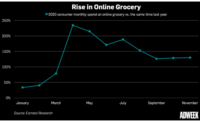Fulfilling short-term needs while maintaining long-term priorities has been an ongoing challenge for organizations since the onset of the pandemic. The global response to COVID-19 has slowed the day-to-day operations of many companies but amplified the progression of transformations that were already brewing before the outbreak. The issue of sustainability through the lens of environmental, social and governance (ESG) principles isn’t likely to be an exception — although an immediate concern for hygiene has caused consumers and organizations to fall back into habits that are conventionally scrutinized for their environmental impact, like discarding plastic and neglecting recycling. Fundamental shifts in prioritization could make it more important than ever for CPG companies to develop marketing resiliency by renewing their commitments to sustainable development.
Supply Chain Disruptions
Supply chain disruptions necessitate a willingness to transform, which could prompt adjustments that unlock sustainability benefits.
As early as March, more than 75% of companies reported disruptions in their supply chains as a result of the outbreak, with some consumer packaged goods manufacturers and food retailers finding themselves unable to keep up with huge spikes in demand, as others faced more challenges upstream. Although the CPG industry has traditionally been slow to adopt digital solutions across their supply chains, it is likely to change as they’re forced to evaluate their current situations and realize how those who have already taken action are benefiting. P&G, for example, which recently reported its largest increase in sales in decades, has been a leader in using artificial intelligence and machine learning to automate demand planning.
COVID-19 is strengthening the incentive for CPGs and retailers to digitize their supply chains, which could result in reduced waste and better energy monitoring, in addition to cost savings. Additionally, this unique situation has created an environment where supply chain transformation can almost be seen as a mandate for long-term success, and within this new environment lies the opportunity to activate sustainability benefits that have remained unrealized for years. Out of more than 1,000 consumer product companies that made organizational changes after participating in surveys led by The Sustainability Consortium from 2016-2018 , 77% of them engaged their suppliers — and their average evaluation scores increased by 30%. When transparency is encouraged by external forces and facilitated by technology, companies are better able to reassess their supply chains, choose partners knowledgeably, and improve their footprints.
Additionally, this unique situation has created an environment where supply chain transformation can almost be seen as a mandate for long-term success, and within this new environment lies the opportunity to activate sustainability benefits that have remained unrealized for years. Out of more than 1,000 consumer product companies that made organizational changes after participating in surveys led by The Sustainability Consortium from 2016-2018 , 77% of them engaged their suppliers — and their average evaluation scores increased by 30%. When transparency is encouraged by external forces and facilitated by technology, companies are better able to reassess their supply chains, choose partners knowledgeably, and improve their footprints.
Designing for Resilience
Designing for resilience will be increasingly important over the coming years, and this idea is at the center of ESG principles that guide companies toward sustainability.
As dramatic and far-reaching as the impact of COVID-19 has been, the short-term shifts we have seen have only given us a glimpse into what a lack of organizational preparation against systemic risks can mean for the future. The current health crisis has generated a reinvigorated focus on building resilient companies that can withstand unexpected disruptions — this same idea is at the center of the ESG principles that guide sustainable companies.
The S&P uses an ESG Evaluation Framework to assess companies’ “ESG profiles” and “preparedness” to deal with environmental, social, and governmental risks and opportunities. Right now, the social factor (which includes Safety Management) is at the forefront of people’s minds. The health crisis has made it critical for businesses to prioritize and protect workers’ health and safety, and to show concern for the communities that they impact. But companies that have shown great commitment to ESG principles understand that it doesn’t end there, and they have made this known to the public. While the threat of climate change is not completely analogous to the threat posed by the coronavirus outbreak, the lessons in preparedness that we are learning, and will continue to learn from the latter, have the potential to enable a stronger infrastructure to combat the former.
Unilever — whose ESG Evaluation clocks in at an impressive score of 89, the highest of any company to date — has viewed this time of uncertainty not only as an opportunity to give back (it has already provided over $500 million in COVID-19 relief across the globe), but also to ensure its continued commitment to the principles of its Sustainable Living Plan and encourage others to follow in its footsteps.
As the number of leaders equating marketing resilience with ESG principles increases, so too will the number of companies that expand their immediate social concerns to long-term environmental ones. This not only produces positive externalities for society but can also serve long-term financial interests — the recent rise of ESG investing indicates that shareholders are finding more value than ever in socially responsible companies.
Consumers and Connectivity
Consumers are experiencing a new level of connectivity, and they apply their health concerns not just to themselves, but also to the world around them.
The efficacy of home care products is currently winning over factors like sustainable ingredients and packaging when it comes to consumers’ priorities, according to a Nielsen report. Additionally, single-use plastics, which conventionally face scrutiny for contributing to waste, are now sometimes necessary to avoid contamination—so consumers are opting to use more of them. However, the immediate focus on health and hygiene does not necessarily indicate that consumers will set aside their concerns about the environment. On the contrary, they are applying their notions of health not only to themselves, but also to the world at large.
“This year we see consumers expressing a more direct link between their health and the health of the planet. This tells us consumers’ pro-environmental sentiments are more than idealistic assertions. When it comes to the environment, consumers mean business,” said Corey Chafin, a principal at Kearney who contributed to a recent consumer study. Fifty-five percent of respondents in the study confirmed that they were “more likely to purchase environmentally friendly products” off the back of COVID-19. This should not be surprising when we consider how transparency and responsibility have grown increasingly important in the midst of this global pandemic.
People and governments are being asked to hold each other accountable for complying with social distancing precautions, maintaining good hygiene, and supporting those who put their own lives at risk to keep everyone else as safe as possible. The unprecedented scale of this collective responsibility will likely permeate the consumers’ choices. Brands should stay keyed in to these consumer motivations, which will help to build resiliency across their marketing ecosystems.
Planning for these shifts is equally as important as recognizing them. Tools that have been at the disposal of companies for years, such as materiality analyses and sustainable policy frameworks, can help businesses understand their own strengths, weaknesses, and opportunities when it comes to ESG factors — this will lay the groundwork for setting effective goals. It is also important for businesses to develop and preserve partners throughout their value chains that can help them reach these goals. Just as COVID-19 is catalyzing an era of transformation, these partnerships will be the catalysts for tangible change at an organizational level.




